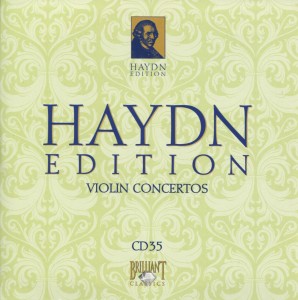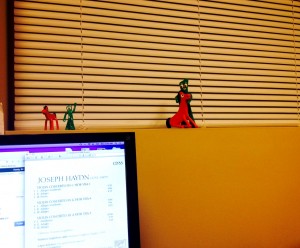 I began this blog entry in the dark of morning. I’m finishing it in the dark of night.
I began this blog entry in the dark of morning. I’m finishing it in the dark of night.
Frankly, I prefer the morning.
By nightfall, I’m tired and I just wanna put on my jammies and watch an episode of Doctor Who.
Thankfully, the music is terrific.
L’Arte dell’Arco, according to the CD sleeve for the Brilliant Classics Haydn Edition, is playing period instruments. In the past, that has meant a headache for me.
Which is so ironic. You see, I’m a purist. I want to hear Classical music the way people in the 17th century heard it.
Problem is they heard, among other things, French horns without valves, which means the players had to swap the crooks to attain a greater range of notes (or they had to develop superhuman lips to reach the notes modern players achieve with valves), and they heard harpsichords instead of pianos. The former isn’t hard on the ears. The latter wears thin quickly. A harpsichord is fine for setting a mood, transporting the listener back to the 17th century quicker than the TARDIS. But, after awhile, that tinny, jangly instrument starts to sound like Captain Quint’s fingernails on the chalkboard.
I once tried to listen to Bach’s complete works on period instruments. I gave it a valiant go for a week or two. Then I just couldn’t take it any more.
In this case, there are no harpsichords.
Don’t get me wrong. I totally dig Christopher Hogwood, founder and conductor of the Academy of Ancient Music. There’s something admirable about people who are so into authentic performances, right down to the kinds of instruments they play. The result is a recorded sound that is often very rich and warm. Maybe it’s just the romantic in me talking. But I think period instruments, playing Classical music, are magical.
But not when it comes to the harpsichord.
To me, that’s the musical equivalent of black magic. Bad juju.
The story of Violin Concerto in C No. 1 is an interesting one. According to its entry on Wiki, it
was written in the 1760s (maybe in 1765) for a well-known violinist of the time, Alois Luigi Tomasini who was just back from Italy and soon became the concertmaster of the Esterházy orchestra.
None of Haydn’s violin concertos exist today in autograph form. This work went unpublished until the mid-twentieth century and has come down to violinists in only very few copies (eight manuscripts).
If “maybe 1765” is accurate (and, gee whiz, a “maybe” sounds pretty definite, doesn’t it?”, then Hayden was 33. (I guess the people who know such things are as in the dark about this one as I am listening to and writing about it.)
The violinist on this recording is, once again, Federico Guglielmo. He is excellent.
But don’t take my word for it. Why don’t you listen for yourself? Here’s exactly what I’m hearing right now:
Information about Violin Concerto in G No. 4 was hard to find. I had to drill down a bit with Google to find it. But I did. On Answers.com. You can read it for yourself here. Or, read this excerpt:
Haydn is credited with four violin concertos, the second of which has been completely lost. This, ostensibly the last of the series, may not be by Haydn; musicologists point out that the idiom is more old-fashioned than that of the other two survivors, which were also written in the 1760s. This could mean, of course, merely that Haydn wrote it before the others.
Here’s the same performance of Violin Concerto in G No. 4 I heard:
Information about Violin Concerto in A No. 3 is equally sparse. Wiki says this was recorded between 1765 and 1770, which means Haydn was anywhere from 33 to 38.
Here’s the same performance of Violin Concerto in A No. 3 I heard:
My favorite movement of Violin Concerto in A No. 3 is Movement III (“Allegro”). It features terrific violin work from Guglielmo, especially starting around the 21:28 mark on the video.
These violin concertos are not my favorites. Concerto in C No. 1 was okay, the best of the three. But, overall, these seem like practice exercises rather than something Haydn spent considerable amounts of time composing. They feel small and almost unfinished.
 But, again, what do I know? I’m no Christopher Hogwood.
But, again, what do I know? I’m no Christopher Hogwood.
I’m just a guy sitting in his office late at night, blinds down, listening to Haydn…with Gumby and Pokey watching him from a lofty perch.
I wish they wouldn’t stare at me.
They know I hate that.

Gumby and Pokey are a bit spooky staring at you from the windowsill like that! I’m amazed you could work Jaws and Doctor Who into a blog about Haydn. 🙂
It’s always sad to me when you find out things have been lost, like a Haydn violin concerto or old Doctor Who episodes. I just wonder why people didn’t realize what they had. Didn’t they know Haydn was somebody important? Didn’t his mom want to save them in a box in the attic for him?